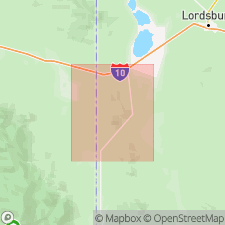
- Usage in publication:
-
- Weatherby Canyon ignimbrite
- Modifications:
-
- Named
- Dominant lithology:
-
- Rhyolite
- Trachyte
- Ignimbrite
- AAPG geologic province:
-
- Pedregosa basin
Summary:
Pg. 70-75, tbl. 1, pl. 1. Weatherby Canyon ignimbrite. [Mapped to south boundary of map; probably extends south for at least another 5 mi.] Rhyolite and some trachyte ignimbrite and thin interbeds of nonwelded tuff. Most of the ignimbrite is light-gray [to grayish-pink] and red hard compact aphanitic-porphyritic rhyolite with phenocrysts of quartz, sanidine, and orthoclase in devitrified matrix of shards and glass shreds. [In the upper part, rhyolite and trachyte rhyolite predominate and are interbedded.] Thickness at least 3,000 feet on 117 Peak and ridges to the west. Younger than Vanar Hills volcanic rocks. [Lack of extensive alteration and probable correlation with Rhyolite Canyon formation of the Chiricahua Mountains, Arizona, indicate age is late Tertiary. No information available about relationships with volcanic rocks in northern part of report area.]
[Type locality not designated.] Named from exposures in Weatherby Canyon, [in secs. 19, 20, and 29, T. 26 S., R. 20 W.], near southern boundary of mapped area of central part of Peloncillo Mountains, Hidalgo Co., NM, [Pedregosa basin]. Particularly well exposed on 1117 Peak, south of Weatherby Canyon. Forms surface rock of most of the Peloncillo Mountains between Cowboy Pass and south boundary of area mapped, and extends southward at least additional 5 mi.
Source: US geologic names lexicon (USGS Bull. 1200, p. 4160); supplemental information (in brackets) from GNU records (USGS DDS-6; Denver GNULEX).

- Usage in publication:
-
- Weatherby Canyon Ignimbrite
- Modifications:
-
- Overview
- Geochronologic dating
- AAPG geologic province:
-
- Pedregosa basin
Summary:
Weatherby Canyon Ignimbrite. Mapped as part of Tertiary volcanic rocks, undifferentiated. Age is Tertiary [Oligocene, based on radiometric dating]; K-Ar age of 25 Ma (W.E. Elston, written commun., 1974).
Source: Modified from GNU records (USGS DDS-6; Denver GNULEX).
For more information, please contact Nancy Stamm, Geologic Names Committee Secretary.
Asterisk (*) indicates published by U.S. Geological Survey authors.
"No current usage" (†) implies that a name has been abandoned or has fallen into disuse. Former usage and, if known, replacement name given in parentheses ( ).
Slash (/) indicates name conflicts with nomenclatural guidelines (CSN, 1933; ACSN, 1961, 1970; NACSN, 1983, 2005, 2021). May be explained within brackets ([ ]).

